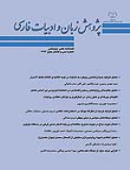تحلیل مقایسهای روایتهای رستم و گشتاسب در شاهنامۀ فردوسی (بر اساس تعامل الگوهای چرخهای و خطی زمان، در شکلگیری و خوانش انتقادی روایات)
محورهای موضوعی : پژوهشهای ادبیات کلاسیک ایرانمعصومه غیوری 1 , محمدکاظم یوسفپور 2
1 -
2 -
کلید واژه: زمان چرخهای و خطی گفتمان روایت رستم گشتاسب,
چکیده مقاله :
شاهنامۀ فردوسی در ادبیات فارسی از جمله کتابهایی است که تاکنون آبشخور آثار تحقیقی فراوان و همواره مطمح نظر بسیاری از محققان ادبی و غیر ادبی بوده است. ساختار ویژۀ چندرشته ای این اثر و تنوع و گستردگی روایات آن مجالی برای خوانشهایی متفاوت با کاربست روش های تاریخ باوری، تحلیل گفتمان و روایت شناسی، در عرصۀ تحقیقات معاصر فراهم آورده است. در این مقاله سعی شده است با جست وجو در سرچشمه های تاریخی، شیوۀ روایت سازی دربارۀ شخصیت های رستم و گشتاسب و نحوۀ تأثیر و تأثر آنها در قالب حماسه واکاوی شود. کاربست الگوی چرخه ای در تدوین و سامان دهی روایات تاریخی عمدتاً به شکل گیری روایاتی با مضمونی اسطوره ای و حماسی می انجامد که وقایع و شخصیتهای تاریخی را در الگوهای زیرساختی از پیش تعیین شده ای، تحدید و استحاله می کند. به همان میزان که شیوۀ تاریخ نگاری متأثر از الگوی چرخه ای به ابهام سرچشمه های تاریخی وقایع و شخصیتها، همسان پنداری و تکرار میانجامد، در این شیوۀ تاریخ نگاری، انتقال خطی وقایع با شگردهای روایت پردازی داستان وار، از آنجا که در سیطرۀ صورتبندی دانایی درک چرخه-ای زمان پرورده شده است، چون تمامی گذشته را انتقال نمی دهد، روایاتی به ظاهر منسجم از وقایعی با سرمنشأهای تاریخی و زمانی متفاوت ارائه می کند. به همین دلیل و با توجه به منظر نوتاریخ باوری، هر روایت تاریخی، داستانی است از گذشته که با گذشته یکسان نیست. در مقالۀ حاضر پس از تطبیق الگوهای دوگانه از درک زمان، با جریان های معرفت شناسی تاریخ، با استفاده از رویکردهای گفتمانی و روایت شناسی، نحوۀ تأثیر الگوهای چرخه ای و خطی در روایات مربوط به رستم و گشتاسب و جای گشت آنها نشان داده می شود.
In Persian literature, Ferdowsi’s Shahnameh has been used as the resource of many researches and an interesting subject for many literary and non-literary scholars. The special multidisciplinary structure of this masterpiece and the diversity and the extent of its narratives provide an opportunity for different interpretations using methods like historicism, discourse analysis and narratology in contemporary research arena. Searching in historical origins, this article aims at studying the way of narrative building in narratives about Rostam and Goshtasb, and they interacted in epic. The use of cyclic pattern in codification and organization of historical narratives mainly leads to the formation of narratives with mythical and epical contents that limits and transubstantiate events and historical characters in the predetermined substructure patterns. As much as the historiography method under the influence of cyclic pattern of time leads to the ambiguity of historical origins of events and characters, identification, and repetition in this method of historiography, the linear transition of events with story-like narrating ploys, provides narratives about events with different historical and temporal origins that appear to be coherent since they are formed under the domination of cyclic perception of time, and they do not transfer the whole past. For this reason, and according to neo-historicism perspective, every historical narrative is a story about the past which is not equal to the past. After matching the dual patterns of time perception with epistemology schools of history, by using discourse and narratology approaches, this article displays how the cyclic and linear patterns influence the narratives related to Rostam and Goshtasb, and their permutations.
